Submitted by WA Contents
The end of FAT: architecture’s biggest pranksters call it quits – boyband style
United Kingdom Architecture News - Dec 18, 2013 - 23:15 7478 views
They've built schools like wedding cakes and are making a real-life gingerbread house with Grayson Perry. But the UK's most playful practice is breaking up after 23 years
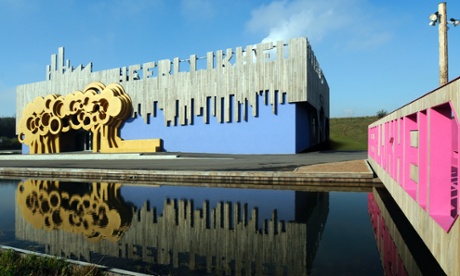
Cookie-cutter whimsy … FAT's Villa community building in Hoogvliet, Rotterdam. Photograph: Maarten Laupman/FAT
They have built a romanesque church out of sparkly blue sequins, aschool that looks like a gothic wedding cake and turned the head of Hercules into a squishy seat. Now, in an unexpected twist, the mischievous London architecture practice FAT has announced it will be no more. Architects usually die, divorce, or go bust – so why the boyband-style break-up?
“We all feel we've completed what we set out to do,” says Sam Jacob, who has worked with fellow partners Sean Griffiths and Charles Hollandfor the last 23 years on everything from art installations to social housing, alongside a prolific volume of writing and teaching.
“FAT was only ever intended to be a project, a way of taking a set of ideas out into the world,” he says. “We still can't believe we've had so many opportunities to make buildings.”
Next summer will see the completion of their final built project, a ceramic-clad gingerbread temple in a field in Essex, designed with artist Grayson Perry as part of Alain de Botton's series of rentable holiday homes. A cross between a Thai wat and an Essex barn, it promises to be one of the most intricately layered concoctions the practice has produced.
“When I spoke to Grayson Perry he said, 'You know that what I hate above all are those sleek cool white glass and steel modernists. They make me feel ill,'” recalls de Botton. “I therefore knew right away that we had to move in a very particular direction – and that there was possibly only player in town who could respond adequately.”
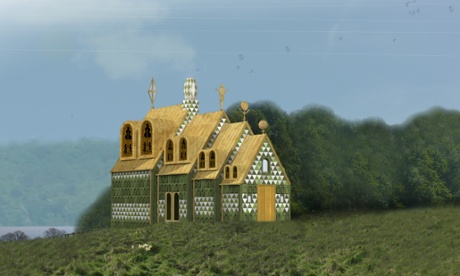
A House for Essex … the Living Architecture holiday home, designed with Grayson Perry Image: FAT
Unlike countless other radical architectural collectives that went before them, such as the hallowed Archigram, FAT's work has not been confined to the safe, hermetic haven of galleries and books. Over the last two decades they have built housing and offices, community buildings and a public library, an art college and a gargantuan TV studio – complete with a 260m-long facade of sci-fi-baroque mouldings.
“It was all a bit of an accident,” says Jacob. “We never imagined we would be a conventional architecture office. It wasn't really a career choice.”
The practice, whose name stands for Fashion Architecture Taste, began as a loose artistic collective in the early 90s, when 20 recent graduates coalesced around provocative tutor Kevin Rowbotham. Coming from backgrounds in architecture, graphic design, film-making and photography, the group began with temporary public art projects that engaged with sites in the city, from bus stops to carrier bags.
“It was born out of a utopian idea that architecture is much bigger than the way architects define it,” says Jacob. “We were looking at the limits of architecture, trying to find moments that you could appropriate, or subvert how the city works.”
Following the common pattern of a young practice, FAT designed a number of exhibitions and nightclub interiors, until their big break came with the office of Dutch advertising agency, Kessels Kramer. Conceived as a whimsical hill-town squeezed into a 19th-century church in Amsterdam, it was more outlandish than any Googleplex orFacebookworld could ever hope to be, and it included a wooden fort, a lifeguard's tower, fragments of astroturf pitches and a meeting room decked out like a fairytale forest.
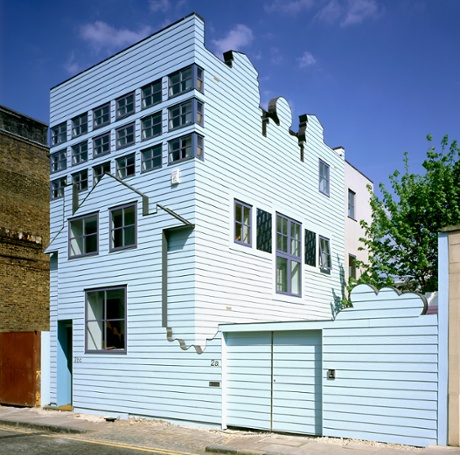
The Blue House … Sean Griffiths' house in Hackney, completed 2002 Photograph: Morley von Sternberg/FAT
It was the first iteration of what would become the trio's trademark approach of surreal sampling and cartoonish collage, taking a rich plethora of references and mashing them together with playful abandon.
“It was all because of Photoshop and Illustrator,” says Jacob. “These tools allowed us to bring all kinds of things together in a very sophisticated collage machine.”
While other offices were exploring the potential of digital technology to conjure fantastical forms from the ether, FAT's approach was refreshingly luddite, using the natural flatness of vector graphics as a way of layering up dense 3D stage-sets, or what they would come to call “figural sections”.
They were egged on by finds from bookshops' bargain basements, amassing tomes on Robert Venturi, Denise Scott Brown and Charles Moore, the unfashionable giants of postmodernism who had been erased from 90s curricular by the prevailing passion for beige.
Venturi's definition of the “decorated shed,” of warehouses smothered in signage that he observed in Las Vegas, became one of FAT's key tenets, as they began to use the depth of the facade as an expressive device.
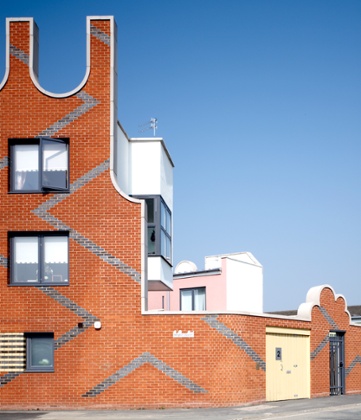
Islington Square … an exuberant brick wall surrounds clever family housing in Manchester Photograph: Tim Soar/FAT
Sean Griffiths' Blue House in Hackney, built in 2002, stands as a powerful distillation of these early ideas. From the street, it depicts the cut-out form of a diminutive pitched-roof house, stuck on to a cartoon office block. It is the ultimate expression of a live-work unit, presented with cookie-cutter clarity. But the flimsy flatness of the facade belies the complexity within, where theatrical stairs, overscaled architraves and ambiguous thresholds produce a finely crafted sequence. It is “Adolf Loos on the inside, South Park on the outside," as Griffiths puts it.
The same tactic was tested on a bigger scale four years later, with a series of terraced houses for Urban Splash in Manchester's New Islington. Here, a great brick wall marches around the development, sporting a loud argyle pattern, its profile swelling and swooping to define each individual house while tying them together, citadel-like with a fortified skin. But again, it is no mere surface whimsy: the compact internal planning behind the garish garb is some of the cleverest of any family housing of the last decade.
Elsewhere, FAT's preoccupation with external exuberance hasn't always led to happy endings. In Middlesbrough's Middlehaven docks, theirCommunity in a Cube, developed for the now-defunct BioRegional Quintain, stands as a surreal domestic triptych. It is a modernist apartment block, resting on a Swiss mountain chalet, with a street of suburban American clapboard homes on the roof. It is a brilliant conceit, with a theatrical entrance up a baroque series of stairs and terraces. But it's hard to stomach the fact that its form means that four rooms per floor look out on a blank wall 3 metres away.
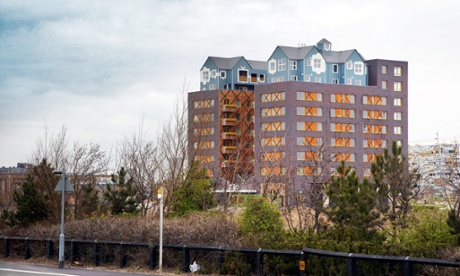
Community in a Cube … the surreal domestic triptych towers over Middlesbrough's Middlehaven docks. Photograph: Rob Parrish/FAT
Like their street at New Islington, which still looks on to overgrown plots, the Middlehaven cube stands alone in a post-industrial wasteland of early Noughties ambition, seeming all the more lonely for its jollity. Just as the riotous frieze of their BBC TV studios in Cardiff Bay faces a bleak prospect of empty plots, it seems the fate of their biggest projects was to stand in empty isolation, shouting jokes out into the void. But what of the practice's lasting influence?
“Keep up the bad work,” Robert Venturi once told FAT, in an utterance of high praise, and it is perhaps their obstinate approach to being determinedly unfashionable that has limited any further success.
“They were too clever by half,” says critic Charles Jencks, the American godfather of postmodernism who has been a champion of their work. “They made a tactical manoeuvre of going explicitly against the tide, which certainly works in the art world, but not so much with buildings. They were always given the B-movie commissions, which is a great shame.”
He compares their trajectory with the rise of Grayson Perry, arguing that while the latter has become “the Hogarth of our times”, FAT haven't had the chance to express their ideas at the scale they deserve.
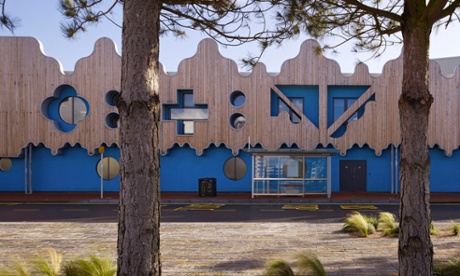
BBC Roath Basin Studios, Cardiff … A 260m-long facade of gothic, baroque and sci-fi mouldings. Photograph: Tim Soar/FAT
“They've stirred up a little bit of trouble, but don't think they had a great effect on the British scene,” he says. “It's because the British don't like explicit taste, fashion and style in architecture any more. In all the other arts they go crazy for it. If FAT had been around with Lord Burlington, everyone would have listened to them.”
Alain de Botton agrees that their outlook represents a sadly rare approach in contemporary architectural culture. “FAT look beyond technological minimalism,” he says. “They are interested in beauty, which makes them extremely strange. It shouldn't, but such is the spurious orthodoxy around 'function' that what should be common sense has come to seem peculiar and whimsical.”
The three partners have yet to announce their future plans, but will end their collaboration at the Venice Architecture Biennale next summer, where they are curating the British Pavilion with Dutch practice Crimsonand writer Owen Hatherley.
“They remain open to offers for a lucrative reunion in 20 years’ time,” concludes the official press release.
“We've got to go on a victory tour,” grins Jacob. “Bands used to take 30 years to reunite, but nowadays they're back together in a couple of months, so who knows ...”
by Oliver WainWright
> via TheGuardian
